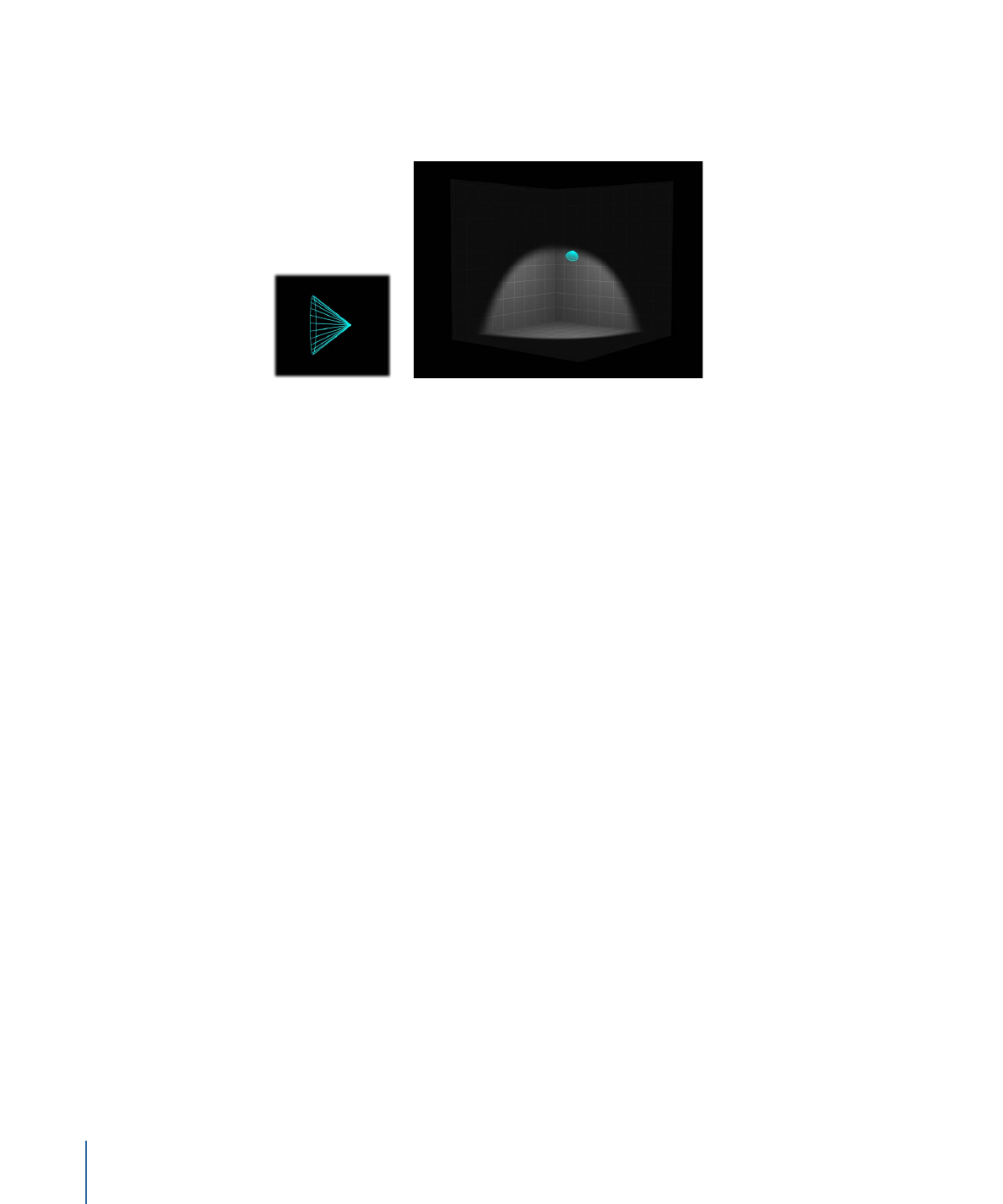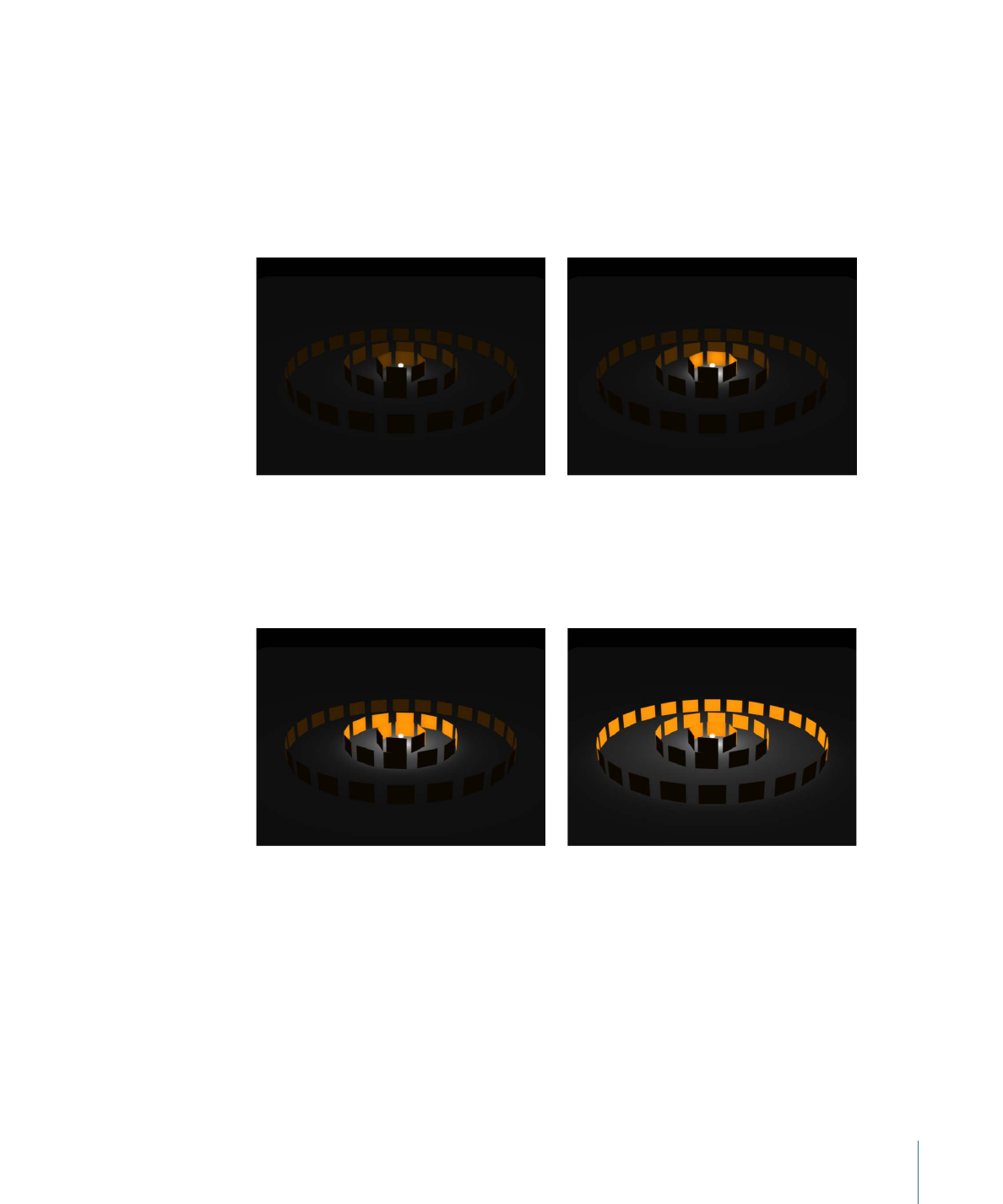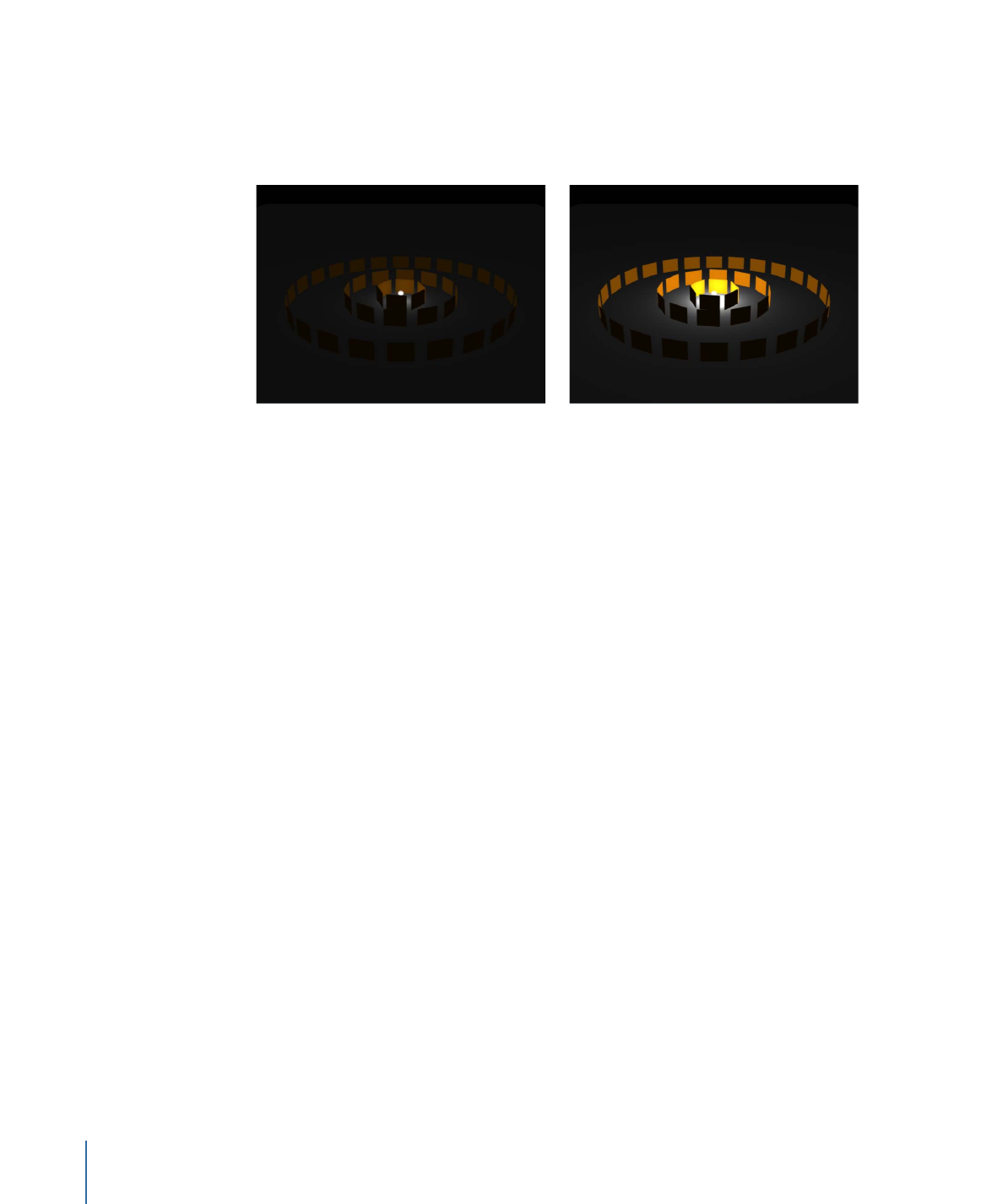
Light Parameters
When you create a light, or select a light object in the Layers list, the Light pane becomes
available in the Inspector.
Parameters in the Inspector
Light Type:
A pop-up menu that lets you choose from four categories of light.
• Ambient: An ambient light emits light in all directions, illuminating all objects in the
scene from all directions equally. This type of light has no position and no representation
in the Canvas. The most common use for ambient lights is to add an overall fill effect
or color cast.
Note: There is no global ambience property in Motion, so you may have to add an
ambient light to prevent total blackness.
1266
Chapter 21
3D Compositing

• Directional: A directional light emits parallel rays of light in a specified direction from
a source located at an infinite distance. Only the rotation of this light has bearing on
its effect. A directional light icon, in conjunction with the transform controls, can be
used to assist in visualizing the direction the light is traveling in a scene. The directional
light icon appears as a cylinder with one end removed. The circle represents the back
of the light, and the lines indicate the direction in which the light is traveling.
Directional light
Example of a directional light
• Point: A point light emits light outward from a single point in 3D space in all directions.
Optionally, you can add falloff based on an object’s proximity to the light. This is Motion’s
default light, and it produces results similar to that of an incandescent light bulb.
Point light
Point light example
1267
Chapter 21
3D Compositing

• Spot: A spot light emits light from a conical light source and casts an elliptical pattern
on objects hit by the light. Using a spot light allows for a high degree of accuracy when
you need to limit the area affected by the light.
Spot light
Spot light example
Color:
A standard set of controls that enable you to select the color of the light.
Intensity:
A slider that cats as a dimmer switch for lighting. If you use a Directional light
at 100% intensity pointed straight at a red object, the object looks red. If you lower the
intensity, the object and scene get darker. However, if you increase the intensity above
100% you can begin to overexpose your scene, eventually causing the object to appear
white. The Intensity value slider ranges from 0 and 400, but there is no upper limit for
Intensity (use the adjacent value slider to set a value above 400).
Note: Multiple lights interacting with an object combine to increase the object’s apparent
brightness as they would in the real world. If you have two spot lights overlapping in
space and pointing in the same direction with Intensity set to 100%, you see the same
result as having a single spot light with its Intensity set to 200%.
Falloff Start:
A slider that enables you to adjust where the falloff point of a light begins.
In the real world, light falls off—or has less of an effect—as the distance from the light
source increases. Usually falloff starts at the center of the light object. Setting Falloff Start
adds additional control to your lighting. This parameter applies to light types that use a
Position parameter (Point and Spot).
1268
Chapter 21
3D Compositing

In the example below, a light is positioned slightly above the origin of the scene. There
are three rings of cards at a distance of 200, 500, and 1000 units from the light. (In this
example, a visible light source—the bulb at the center of the rings of cards—is simulated
for illustrative purposes.) The light’s Intensity is set to 100% and Falloff is set to 10%. When
Falloff Start is set to 0 (left, below), the light begins to fall off by the time it hits the
innermost ring. When Falloff Start is set to 200 (right, below), the inner ring is lit at 100%
intensity and the outer rings are slightly brighter than before.
Falloff Start set to 0
Falloff Start set to 200
When Falloff Start is increased to 500 (left, below), the inner and middle rings are lit at
100% intensity, and the outer ring is brighter than before. Finally, when Falloff Start is set
to 1000 (right, below), all rings are lit at 100% intensity.
Falloff Start set to 500
Falloff Start set to 1000
1269
Chapter 21
3D Compositing

In the next example, the image on the left contains a light with Intensity set to 100%,
while the image on the right has a light Intensity of 500%. In the image on the right, the
outer rings are slightly brighter, but the innermost ring is overexposed. If the Falloff Start
of the light in the image on the right is increased to 1000, the rings are overexposed.
Intensity set to 100; Falloff Start set to 0
Intensity set to 500; Falloff Start set to 0
Falloff:
A slider that controls the rate of falloff for a point or spot light based on the Falloff
Start setting. At low values, light falls off over a long distance from the light source;
therefore, the light travels farther in the image. At high values, the falloff occurs more
rapidly.
Cone Angle:
A dial that becomes available only when Light Type is set to Spot. The Cone
Angle is measured from the center of the light outward. The angle may be set to a value
between 0 and 90 degrees. The distance of the light from its target affects the result of
this parameter. If the light is close, a wider spot cone angle may be needed to light more
of the object. If the light is further away, a lower Cone Angle may be needed to isolate
objects.
Soft Edge:
A dial that becomes available only when Light Type is set to Spot. Like Cone
Angle, this parameter can be set to a value between 0 and 90 degrees. Its starting point
begins at the outer edge of the Cone Angle. If set to 0, spot lights have a hard edge. Low
values produce a slight softening effect to the boundary of the lit area. Higher values
produce a wide, more natural fade. Adding softness expands the area of your light, so
you might need to adjust the angle to achieve a specific effect.
Note: Point lights and spot lights also contain a set of parameters to control how they
cast shadows. For more information on these parameters, see
Shadows
.
HUD Controls
The Light HUD contains the Light Type, Color, Intensity, Falloff Start, and Falloff parameters,
which are also available in the Inspector. The Light HUD also contains 3D transform
controls. For more information, see
3D Transform HUD Controls
.
1270
Chapter 21
3D Compositing